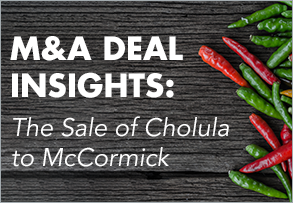SDR Ventures’ Principal, Geoff Eliason, recently went on The Deep Dive podcast hosted by the RIA Channel to discuss the benefits of wealth advisors and investment bankers working side-by-side to better serve the needs of business owners. The podcast was hosted by Jay Hummel, Co-Founder of The Wealth Advisor Growth Network.
August 2022
3 Key Considerations Before Selling Your Business
After serving middle-market business owners for nearly two decades, SDR understands the immense complexity and abundance of considerations that are coupled with an M&A transaction. We find that many of our clients at the beginning of an engagement are simply thinking of the dollar amount that will hit their bank account on the day of closing. What business owners often fail to account for is the outlying considerations within the broader M&A landscape as well as their near and short-term business operations.
ITR Economics recently published an article detailing 3 Important Questions to Answer Before Selling Your Business. ITR rightly points out that post-tax cash is not the only economic considerations that business owners considering a transaction should focus on. The article goes on to explain that business owners should thoughtfully reflect on and answer the following questions before embarking on a potentially life-changing transaction.
- Where you are in the business cycle?
- Where your markets are vis-à-vis the business cycle?
- Will waiting to market your business afford you the opportunity to increase your EBITDA?
SDR understands that there are unique situations in which business owners have a high sense of urgency given personal considerations, however, there are many instances where it is in the business owner’s best interest to press pause on their M&A goals and focus on preparing their business for sale. Time (and timing) is the enemy of a successful M&A transaction. Whether due diligence is halted due to a performance issue, a macro-market is at its peak or in a valley, or business development faces a disruption or slows down, time will pass, and with it, the attractiveness of a business. One thing is for certain when looking to sell a business, strike while the iron is hot.
Read ITR’s detailed coverage of the topic here.
If you or another business owner in your life are interested in exploring M&A options, including evaluating the questions listed above, our team of M&A professionals is here to help. Please contact Scott Mitchell at smitchell@sdrventures.com or call our offices at 720.221.9220.
The Pre-investment Roll Up: How Selling Several Companies At Once Can Increase Multiples
Article Overview
Over the last 18 months, the SDR Ventures Team has taken a page out of the Private Equity playbook and successfully deployed a unique sell-side strategy to generate premium valuations for its clients. The strategy, which SDR labels the Pre-investment Roll Up (PIRU), creates value through consolidation by marketing two or more companies as a single investment.
By leveraging its long-standing relationship with Axial, SDR was able to complete its most recent Pre-investment Roll Up with a highly qualified and like-minded buyer identified through Axial‘s platform. Following the success of the transaction, Scott Mitchell, Managing Director at SDR Ventures sat down with Axial to discuss the events leading up to the transaction and how the same strategy could be optimized for business owners in a similar position.
To read Axial’s full coverage of the Pre-investment Roll Up strategy, click here.
The PIRU Pillars
SDR has identified five elements that make PIRU deals work.
1. Casting a Wide Net to Find Sellers
The advisor will need to reach out to many potential participants to find a group of complementary companies that can be sold together.
2. Creating a Unified Vision for the Combined Company
Once the sellers come together, they need to agree on a “straw man” organization chart for the combined company.
3. Agreeing on How to Share Proceeds
While the operating plan doesn’t need a formal agreement, the sellers need to commit in writing to how they will divide any sale proceeds.
4. Imposing Penalties on Sellers That Back Out
There’s no way to force a prospective seller to go through with a deal if the owners change their minds.
5. Simplifying the Transaction for Buyers
The sellers must appoint one law firm as lead counsel for the group, for example. And since sellers have agreed in advance on how to split the proceeds, buyers only need to offer a single purchase price.
What Is Your Plan for the Next Chapter?
Have you been considering a sale, recapitalization, or financing to grow your business? If you are interested in exploring your options, our team of M&A professionals is here to help. Please contact Scott Mitchell at smitchell@sdrventures.com or call our offices at 720.221.9220.
Private Equity Roundtable: State of the Lower Middle Market
Roundtable Overview
During a recent virtual roundtable hosted by GF Data, SDR’s Scott Mitchell joined fellow M&A professionals to discuss the state of lower-middle market M&A and private capital markets. The roundtable consisted of 40+ professionals from the Rocky Mountain Region.
Advisory Panel Members:
– Private Equity Investors
– Investment Bankers
– M&A Accounting Professionals
– M&A Legal Firms
What Is Your Plan for the Next Chapter?
Have you been considering a sale, recapitalization, or financing to grow your business? If you are interested in exploring your options, our team of M&A professionals is here to help. Please contact Scott Mitchell at smitchell@sdrventures.com or call our offices at 720.221.9220.
Discussion Highlights
Valuation Multiples in the COVID Era
While the initial economic slowdown caused by COVID-19 sidelined many active transactions for a quarter or two, we have seen M&A activity (especially in the lower-middle market) recover in recent months. Beyond the bounce back in deal flow, there has been a notable increase in valuation multiples for companies that can prove their economic resilience during the pandemic.
While overall valuations lagged in 2Q20 & 3Q20, the availability of capital for private market transactions continues to drive multiples higher. The increasing demand for quality assets coupled with the amount available “dry powder” in the lower middle market is greatly outpacing the volume of strong acquisition targets hitting the open market. It’s Economics 101, when demand continues to rise while the supply of quality assets dwindles, prices rise.
Looking Forward
Among the event’s participants, the consensus is that there will be a surge in M&A activity in 2021. This is partially because aging business owners who were planning on selling, but not fully committed to doing so, before the pandemic are once again able to achieve fair and even above-market valuations. Many don’t want to chance a potential recession or face rising taxes during the current administration.
Although the credit markets slowed in Q2 & Q3-2020 for M&A financing, they are once again “open for business” and leverage multiples and interest rates for M&A transactions have largely returned to pre-pandemic levels.
Additionally, large strategic buyers continue to lag behind private equity in terms of focusing on M&A activity as the economy continues to rebound from COVID-related setbacks. To the extent strategic buyers are pursuing M&A, many are currently targeting large “transformational” transactions. While the “transformational” trend has dampened activity in the lower middle market, we anticipate that strategic buyers will become more active in the back half of 2021, and once again target smaller acquisitions.
Overall, 2021 appears to be headed for a significant surge in deal activity at strong valuations.
M&A Roundtable Takeaways: Preparing for a Transaction
Roundtable Overview
During a recent virtual roundtable hosted by Axial, SDR’s Scott Mitchell joined fellow M&A professionals to discuss common questions and concerns of business owners looking to complete a transaction process.
The questions and discussion framework were provided by a curated group of business owners and operators participating in a variety of industries including Media, IT, Technology, Industrials, Biomedical and Events & Catering.
Advisory Panel Members:
– Scott Mitchell, Director of Investment Banking, SDR Ventures
– Spencer Clawson, Partner, Peterson Partners
– Thomas Courtney, President & CEO, The Courtney Group
– Doug Rodgers, Chairman, Focus Investment Banking
To read Axial’s coverage of the roundtable event, click here.
What Is Your Plan for the Next Chapter?
Have you been considering a sale, recapitalization, or financing to grow your business? If you are interested in exploring your options, our team of M&A professionals is here to help. Please contact Scott Mitchell at smitchell@sdrventures.com or call our offices at 720.221.9220.
Discussion Topics & Takeaways
Preparation & Timeline
Begin thinking about a transaction 3-5 years out to provide plenty of time for business owners to prepare the team. During this time, business owners should:
– Become familiar with different players in the space.
– Get to know a variety of buyers.
– Study up on all the necessary materials needed for a smooth transaction.
Once a business owner is about a year out, they should find a lawyer, investment banker (and anyone else they would like to add to their transaction team), and discuss what they will need to pull together the required materials.
Life comes at you fast, and the ideal scenario and picture-perfect timeline rarely presents itself. Because life comes at you fast, business owners should begin the M&A/capital raise education process as early as possible. An important characteristic of a successful business owner is having the awareness to surround yourself with people you can ask questions to. Talk to investment bankers. Get introduced to investors. Preparedness comes through consistently having discussions like this over time.
Understanding Your Financials
Investing in accounting — while not very exciting —is ultimately worthwhile, especially if/when you decide to transact. As a business grows, the operators should consider moving to GAAP, which is a standardized accounting system that makes it easy to compare financial statements.
Consider performing financial audits and quality of earnings studies before the transaction process. While it may not be standard practice for small businesses, clean financial statements can provide a level of credibility for businesses looking to transact.
To learn more about the benefits of conducting a quality of earnings study, click here.
Axial CEO Peter Lehrman sums up the topic, “If you’re massively underinvested in the financial hygiene of your business, you’re headed for really rough sledding in a capital raise of any significance, or certainly in an M&A transaction.”
Management Considerations
Many of the entrepreneurs were interested in hearing more about the pros and cons of professional management. Many small businesses don’t have the resources to bring in professional management teams, so how do investors and buyers think about the professionalization of management versus the development of the existing team?
No question having a built-out management team increases the attractiveness of your business to a wider range of investors. There is no one right answer as far as developing talent in-house or bringing it in from the outside. However, outside talent is a riskier proposition so, if possible, these hires should happen well in advance of a sales process to make sure they are the right fit for the organization. Additionally, business owners should focus on talent that has the potential to impact revenue growth or margin improvement the most. Finally, if a business owner is looking for a near-term exit post-transaction, his or her salary may be “added back” to profitability if a capable president or CEO is in the business.
Investment Banks: To Hire or Not to Hire?
One of the most common questions we received from business owners was around the use of an investment banker. Should I hire one? What are the pros and cons of working directly with an investor or a buyer? Can I get through a transaction by myself? If I do use one, how do I find the right M&A advisor?
While it is possible to do a deal directly with an investor and buyer without an intermediary, all of the deal professionals agreed that even if you don’t hire a banker, you’d be remiss to not at least talk to one before transacting. And generally, the less experienced you are, the more it makes sense to work with a professional to ensure you’re well prepared and ultimately getting the best valuation for your business. Scott Mitchell, Director of Investment Banking at SDR Ventures, notes he has seen entrepreneurs successfully “DIY” their way through a transaction but notes that a lot of those management teams had prior M&A experience, and still fact-checked with many different individuals throughout the process.
Investment Banks: Fee Considerations
One of the entrepreneurs on the call working on a $5M capital raise brought up the topic of banking fees. After one call with a prospective banker, the CEO received a letter of engagement. Receiving an engagement letter after one call was cause for concern for this CEO – is the banker looking to collect a retainer without actually knowing if the capital raise was a viable option?
It turns out that this business owner’s concern was very legitimate. “You’re right to have alarm bells going off there,” Scott commented. “Your Spidey senses are up for a reason.” Scott goes on to explain that SDR only engages with about 20% of the businesses they speak with, and that’s because they only want to work with businesses that they can successfully help transact.
While engagement fees may seem expensive, it doesn’t come close to covering the banker’s cost (if they’re doing a good job).
One panel participant advised, “The key thing in the relationship with an investment banker is that you have chemistry with them, you have trust in them, and want to hear what their advice is.”
Scott agrees with these sentiments and says that SDR focuses on being a client advocate rather than a deal advocate. “If you’re going to work with someone who is going to go with zero down or very little engagement fee, no matter what deal they put in front of you, they think it’s a good deal,” he says. “They want you to close that deal because that’s the only thing you’ve incentivized them to do.”
How Partnering With the Right Private Equity Partner Can Produce Outsized Results
M&A Deal Insights: The Sale of Cholula to McCormick
On November 30, 2020, Private Equity firm L Catterton confirmed the successful sale of the popular Mexican hot sauce maker, Cholula Food Co to McCormick & Company (NYSE: MKC) for $800 million. With Cholula’s reported 2020E sales of $96 million and ~$32 million in EBITDA, the deal translates to ~8.3x revenue and ~25x EBITDA: an outsized outcome for L Catterton by any standard. L Catterton was able to realize 4x its investment in Cholula since buying the majority of the business in April 2019, according to an article published in Food Processing.
So, what made the deal so attractive to McCormick that they agreed to anti-up such a high multiple? Even more interesting, what was L Catterton able to accomplish in such a short time that would drive the value of Cholula to such stratospheric multiples?
According to L Catterton’s press release, the value-creation program over its nineteen-month ownership period was multi-faceted and included recruitment of industry-leading talent, operational improvements, and heavy investments in Cholula’s brand and marketing by increasing awareness and loyalty. L Catterton was able to increase household penetration by over 50% during its short ownership period.
According to Cholula CEO, Maura Mottolese, “L Catterton… vastly improved our commercial execution efforts, and pivoted our foodservice strategy to position Cholula for long-term growth and success. L Catterton was well-positioned to acquire and grow the Cholula business by virtue of its global footprint, including its presence and local team in Mexico.”
According to an interview with CNN, Mottolese outlined that 40% of consumers learn about Cholula through their in-dining experience at restaurants. At the onset of the pandemic, foodservice sales dropped dramatically, so the company needed a new strategy. It chose to focus on the co-branding of new menu items and new packaging. It also pivoted its retail grocery strategy with the introduction of a new 2-ounce bottle for consumers to sample, as they began cooking more at home.
L Catterton is no stranger to effectively growing middle-market CPG companies. With $20 billion of invested equity, L Catterton claims to be the largest and most experienced CPG-focused Private Equity Group in the world.
Although Cholula’s hot sauce recipe has been marketed and sold in Mexico for years, it was first introduced in the U.S. in 1989 and is now sold in over 20 countries. The product line is made with a unique blend of peppers combined with a secret blend of signature spices. Since the brand was first introduced into the U.S., it has been effectively marketed as “The Flavorful Fire” through sporting events such as snowboarding, football, baseball, and joint promos with restaurant chains such as Papa John’s. In 2019, it launched “Tacopedia”, a series of interactive exhibits described as “an Instagrammable Amusement Park Disguised as a Pop-up Museum”.
According to Lawrence Kurzius, McCormick Chairman, President, and CEO, “McCormick has a history of creating value through acquisitions. We have a proven track record for achieving our plans and accelerating the performance of acquired brands. We plan to grow Cholula by optimizing category management and brand marketing, while also expanding channel penetration.”
In an investor presentation, McCormick outlined the following as the key drivers behind the acquisition:
– Accelerates McCormick’s global condiment platform and growth opportunities
– Strongly complements McCormick’s portfolio
– Capitalizes on the growing consumer interest in healthy and flavorful eating
– Broadens McCormick’s product offering to consumers and foodservice operators
– Meaningful margin accretion in Consumer and Flavor Solutions segments
– Hot sauce is an advantaged high growth category
– Leading Mexican hot sauce that is outpacing U.S. hot sauce category
– Beloved premium brand proudly made in Mexico
– High-quality ingredients in a 100-year-old recipe
– Asset light strategic third party manufacturing model
– Strength in retail and foodservice
– Strong margin profile
McCormick became intimately familiar with the trends impacting the hot sauce market through its acquisition of Frank’s RedHot Hot Sauce in 2017, as part of a $4.5 billion deal with RB Foods.
According to Statista, the hot sauce market in the U.S. is currently a $1.5 – $1.55 billion market and expected to grow to about $1.65 billion by 2022. Nielsen estimates that U.S. hot sauce sales have grown an average of 9.7% annually for the past four years.
Here’s the first take-home message… Outsized exit multiples are achievable through thoughtful positioning and strategy execution including:
– High-quality distinctive product line with growing sales and high margins
– Rising tide for a product category
– Brand marketing and management expertise
– Smart capital
– Strong fit with well-capitalized industry leader
The second take-home message… While it is unclear how much scale was driven by L Catterton’s investment during its ownership, this deal is an outstanding illustration of how private company owners can partner with Private Equity to become highly attractive, middle-market companies when they choose to partner with the right firm. Even more importantly, when owners roll equity through a PE recap, the rewards for a two-step exit plan can be truly outstanding!
Prepared by Eric Bosveld and Vijay Malhotra, B&A Corporate Advisors







